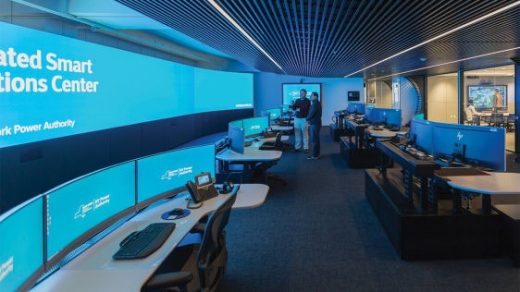If We Want Renewable Energy, We Need Fully Digitized Power Systems
With 16 generating facilities and around 1,400 transmission lines, the New York Power Authority is the state’s largest electric utility and the largest state-owned utility in the U.S. And as of this month, it will be the world’s first fully digital utility–a move that NYPA hopes will help it hit Governor Andrew Cuomo’s goal of generating 50% of its power from renewable resources by 2030.
Through a partnership with General Electric, NYPA will create digital replicas of every one of its assets, from generating facilities to substations to transmission lines, which they will monitor out of its new Integrated Smart Operations Center (iSOC) in White Plains, New York. The iSOC will also monitor over 11,000 public buildings in New York State, which will allow NYPA to track how their clients are using energy, and determine ways in which they could optimize their usage.
The digitization progress will essentially allow NYPA to track power generation and transmission across all its assets, says NYPA President and CEO Gil Quiniones, adding that GE’s Predix platform, which the utility is adopting, will allow NYPA to monitor the health of all of its generating facilities, and to detect and possibly prevent power outages and grid meltdowns before they happen.

For New York, this real-time, “smart” energy monitoring system will be crucial, Quiniones says. NYPA provides the energy which fuels, for instance, all 600 miles of New York City’s subway system and its major airports. It also provides energy to 51 smaller, local utilities across the state. And as more and more assets (like vehicles, for instance) switch from oil and gas to electric, it will be more important than ever for utilities to be able to track where energy is flowing, down to the smallest scale, like charging stations.
Housed on the eighth floor of NYPA’s headquarters in White Plains, the iSOC will be the first of three new digital hubs for NYPA. Inside the iSOC, computers constantly analyze each of the digital replicas of the NYPA assets and buildings and operate, Quiniones says, “like a continuous MRI, so we actually know what’s going on 24/7. If we’re looking at an energy transformer, for instance, we can tell if there are dissolved gases in the oil of that transformer, which could create problems; we have digital infrared cameras monitoring it to detect if there are any spots where the temperature is too high.” The GE platform will be performing big data analytics in the background, and learning patterns of energy flow and usage that could precipitate disruptions or complications in the system.
This latter capability will be particularly necessary as the state begins to integrate energy from more renewable sources. Grid instability is one of the biggest concerns about converting to renewables–if there’s, say, a large influx of wind power at a particular time, utilities currently lack the flexibility and insight to be able to seamlessly integrate that new supply into the current system. But in the iSOC, Quiniones says, NYPA and GE have built out a lab specifically to simulate and track the power grid. For the lab, NYPA is partnering with other utilities and the grid system operator to “create a very granular and dynamic model of the whole grid system for New York,” Quiniones says. “By doing so, we can really take the planning and operation of the grid to a completely different level, because we can do a lot of ‘what if?’ scenarios.” NYPA now has the capability to model what would happen if they added another transmission line to the grid, or if they added input from a new wind or solar farm to the grid.
Apart from political opposition, uncertainty about the ability of the grid to handle renewables is perhaps the main barrier to more sustainable energy sources becoming mainstream. But NYPA’s effort to digitize its whole system in order to track exactly how energy flows around the state creates the necessary transparency for the utility to begin to integrate more renewables in a methodical, informed way.
Fast Company , Read Full Story
(30)



